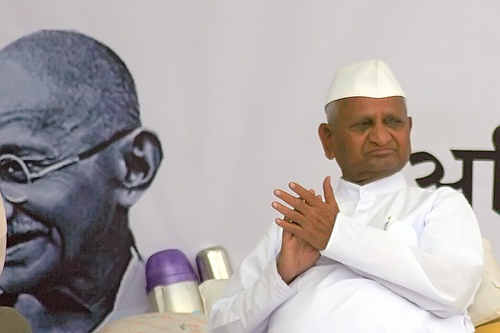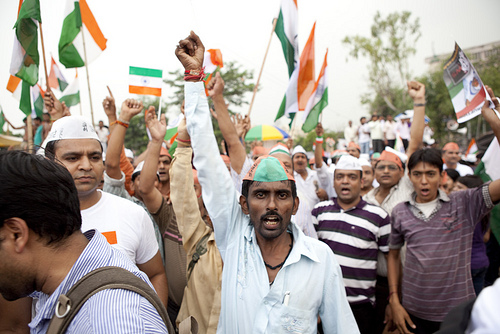Corruption in South Asia is not a problem, it’s not an epidemic – it’s a way of life. In Pakistan, and in India as well, from the smallest fruit vendors, to the factory owners, to the highest echelons of the political sphere, everyone asks for, and doles out, bribes. Even our Prime Minister, Mr Zardari, known commonly as ‘Mr 10 per cent’ (and up to ‘Mr 50 per cent in some circles’) is no stranger to this culture. Really, if one does not siphon off their ‘cut’ in business dealings, they are considered a bit naive.
But now, in the world’s largest democracy, one man, Anna Hazare, is leading a nationwide non-violent crusade for social and political change against corruption. The 74-year-old veteran social activist ended his 13 day hunger strike on 28 August, which saw tens of thousands of supporters come to Ram Lila where he sat. Many more also drove to the houses of various ministers in protest. The support he has received across India is enormous. Anna, whatever his techniques, has brought the issue of corruption in the highest circles of Indian life to the limelight and spurred a process of change.
This apparent “second freedom struggle,” as Anna likes to call it, is a culmination of two years’ worth of high-profile corruption scandals and subsequent calls for political reform. Earlier, Anna rejected the Indian government’s proposal for a new anti-corruption bill as much too weak. He instead pressed the government to adopt his suggestions to create a strong national anti-graft ombudsman, or for the government to at least gather the relevant parties and himself to debate a new bill, which they have promised. Anna’s tactics seem to have worked. The Indian government bent under the pressure and drafted a compromise. A deal was made on the 28th, the day before he ended his fast.
But there are legitimate criticisms of Anna’s ‘freedom struggle.’ Mainly that the focus of his attention on corruption seems to have been concentrated on the political ranks which affect mainly the middle classes. The lower classes and castes were fully aware they were not being addressed and have remained noticeably absent from the movement. Other critics suggest that Anna’s success owes mainly to the fact he appropriated the Gandhian image and mood the of the 1945 Independence Struggle as his own. The media have certainly enjoyed playing up his Gandhian image.
Yet perhaps this is what India needs right now. Anna’s traditional style and words are striking all the right notes with a large enough section of the Indian public, and his unyielding tactics with the government are forcing them to act on something they would not do otherwise. In an extremely diverse nation, Anna Hazare is using old and simplistic words and images to circulate his movement across the middle classes of Indian society, which today is otherwise modern, consumerist and incredibly diverse. His campaigning group, ‘Team Anna,’ is sending messages of austerity and traditional virtue via mediums such as Facebook and Youtube. Having long since embraced western consumerism and modernisation, it seems like this is exactly what the Indian middle classes have been wanting to hear. This movement took a very traditional Indian language and placed it in a modern context – this is India making its own style of political discourse.
Yet Anna’s methods are also gathering criticism. India claims to be the world’s biggest democracy, all free and fair functioning. Anna’s critics point out how his single-mindedness on what he wants and how he wants it, though undeniably effective, is essentially anti-political, in that by circumventing the established processes he inherently discredits the Indian parliament, its legislative process and its entire elected arrangement. Instead, his movement used a method typical to South Asia, that of the personality, of a messianic character. Not a sustainable political platform. These criticisms are certainly all true to some extent, yet they can possibly be overlooked as something necessary in India’s current political climate and constitution. What is a more noticeable criticism is that the language of his movement was not only traditional, but right wing and religiously conservative with strong Hindu overtones, immediately excluding religious minorities. Though he denies links with the very right-wing BJP, Anna’s image of India remain the conservative rural, vegetarian ideal, and he immediately excluded all Muslims by doing his fast in the month of Ramadan when Muslims must avoid dispute and protest.
I think a bigger criticism would be that Anna Hazare’s tactics are not broad enough. He focusses on the political elite and main bodies of government. Corruption does not just exist at government level but is inescapable throughout society, and an anti-graft ombudsman would do little to tackle the problem. For India to really rid itself of rampant bribery and fraud, they need to focus on the lower levels of corruption as well, from the schools to the police to local businesses. Only then could they hope to really weed out this unfortunate custom.
Yes for all his faults, Anna Hazare has done a great service to India. He has chastened India’s political classes by bringing their wrong doings into the glare of publicity, and taken political strength and authority, perhaps not the infinite masses, but at least to the extensive middle classes.








